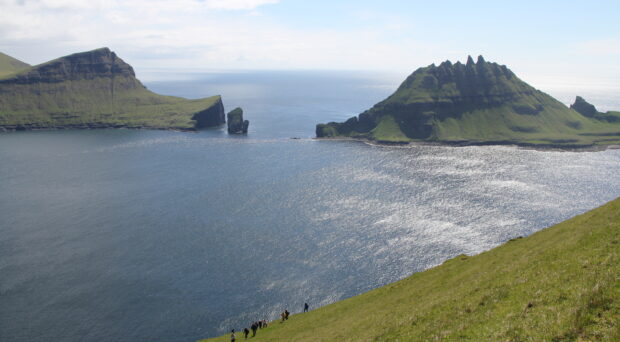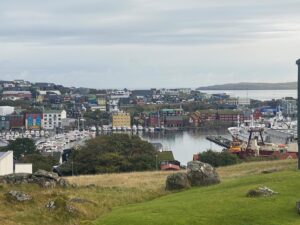
Genetic population isolate
Archaeological research suggests that the Faroe Islands were founded in two pre-Viking phases around 300-500 AD and 500-700 AD, before the Viking settlements in the 9th century.
This population is well-suited for genetic research because it was geographically isolated. Indeed, the current population of about 50,000 people is believed to descend from a low number of settlers, who thus had few opportunities to find a partner. This is called a bottleneck effect, which often leads to inbreeding from mating between close relatives.
SNPs (Single Nucleotide Polymorphisms) are mutations of single DNA-bases, A, C, G, or T, at specific positions in the DNA sequence as compared with a reference genome. Each person has over 3 million SNPs, and these are of great interest in genetic research.
People have two copies of chromosomes, one from each parent. Therefore, we inherit two identical or two different copies of each SNP. The two copies, denoted genotypes, are called homozygotes if the copies are identical and heterozygotes if the copies are different.
SNP heterozygosity H is a measure of genetic diversity. It is the number of heterozygous genotypes divided by the total number of genotypes. High and low H means, respectively, a high and low genetic diversity. It is desirable to have high H because a low genetic diversity and inbreeding can increase the risk of genetic diseases.
Genetic diversity and inbreeding
In this paper, the whole genomes of a small sample of the population are analysed using bioinformatic methods. The results show that H is relatively high for individual samples because individuals have many private SNPs, likely of recent origin. On the contrary, H is low for the SNPs that are shared by the population and therefore are likely of older origin.
Long sequences of SNPs that mainly contain homozygous genotypes are called ROHs (runs of homozygosity). In the paper, ROHs are used to estimate the inbreeding in the Faroese population as compared to both modern and ancient European populations. The inbreeding of the Faroese population is high compared to European populations and population isolates. Thus, it has inbreeding which is more similar to ancient Europeans.

Two methods to estimate relatedness
To estimate the relatedness between individuals, two methods based on whole genomes were investigated. One of the methods (KING kinship) cannot distinguish between ancient and recent relatedness. Therefore, all the supposedly unrelated participants seemed very closely related as siblings or parent-offspring relationships. However, using a method based on ROHs, the author is able to show that the high relatedness is of ancient origin.
In this study, the author discovered a bottlenecked and consanguineous population event and estimated it starting around 50-300 AD.
The bottleneck effect from the founding event
Then a search for the bottleneck effect was carried out. An older genetic study of the Faroese population was unable to find such an effect. In this study, the author discovered a bottlenecked and consanguineous population event and estimated it starting around 50-300 AD.
The higher limit of this estimate agrees with the oldest archaeological findings from the Faroe Islands, while the lower limit suggests that the founding event may have occurred about 2-3 centuries earlier than previously believed based on archaeological evidence.
After the founding event, the bottleneck effect increased from about 300 AD to 600 AD, where it was the highest. Thereafter, the bottleneck effect slowly decreased, most likely from an increase in the population size from the arrival of new settlers.
Comparison with the 1000 Genome Project
Other results in this study were about ancestry and clustering (Multidimensional Scaling) as compared with the international 1000 Genome Project, where whole genomes from several different populations were studied.
The Faroese results about ancestry showed that the study participants descended from founders of mainly European ancestry (>99% probability) and possibly some admixed American ancestry (<1% probability).
The study participants that cluster closest together are genetically most similar. The Faroese participants clustered all close together and distinctively away from the other populations but closest to the European and British populations of the 1000 Genome Project. Finally, the study showed that the Faroese people have many rare SNP variants. Such mutations are of great interest for genetic research.
Comments